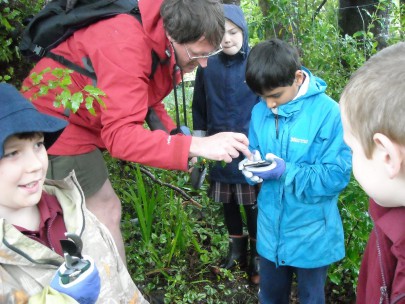Kaniere School, Westland
In this section
-
Participating schools
- Curious Minds visit Lincoln
- Franz Josef & Fox Glacier Schools
- Greymouth High School
- Haast School
- Halswell Domain
- Halswell School
- Heathcote Valley School
- Kaniere School
- Kaniere visit Lincoln
- Hokitika Primary
- Leeston Consolidated School
- Manuka Primary School
- Mission Heights
- Mt Albert Grammar
- Paroa School
- Rudolf Steiner School
- Takapuna Grammar
- TKKM
- Wakaaranga Primary School
- Whataroa School

Murray in the field with students.
On our first afternoon with the school, we held our inside activities programme which fully engaged the students, who were all very keen.
During the following morning, Murray Dawson, Robinne Weiss, teacher Jenny Barrow and several parent helpers supervised the students for a field trip around the edge of the Kaniere Tailings, located immediately behind the school.
After we finished our visit, the school nominated their Y5 student Sam to attend our two-day education programme at Landcare Research in Lincoln.
- Also see teacher Jenny Barrow's school blog on our visit.
- In August 2017, Kaniere School visited us at Manaaki Whenua – Landcare Research to learn more about weeds, biocontrol, the Allan Herbarium and the national harakeke (flax) collection.
What were some of the plants that we found?
Because this area had been highly disturbed through the past activities of gold mining, and was probably cleared of all native vegetation at some stage, it provided ideal conditions for the invasion of weeds.
Sure enough, large bushes of Franchet's cotoneaster (Cotoneaster franchetii) were dominating the tailings and there was also abundant butterfly bush (Buddleja davidii), Himalayan honeysuckle (Leycesteria formosa) and tutsan (Hypericum androsaemum).
Other environmental weeds were common, including:
- blackberry (Rubus fruticosus)
- crack willow (Salix × fragilis)
- European holly (Ilex aquifolium)
- gorse (Ulex europaeus)
- purple foxglove (Digitalis purpurea)
- Scotch broom (Cytisus scoparius)
- wild brassica.
There were also a couple of patches of aluminium plant (Lamium galeobdolon 'Variegatum') and a large area of English ivy (Hedera helix) sprawling along the undergrowth and banksides.
We also saw some well-established sycamore (Acer pseudoplatanus) and English oak (Quercus robur) trees, which must have been originally planted. These specimen trees were producing seedlings by the thousands. This is a very weedy site!
The few native shrubs we noticed included:



















